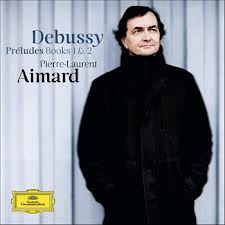As with his previous solo Debussy CD (the Images and Etudes) Pierre-Laurent Aimard’s Préludes contain both incandescent and matter-of-fact performances. In Book 1 he maintains the pianissimo marking of Voiles’ B-flat bass pedal point with remarkable consistency, providing a gentle anchor for the drifting whole-tone chords elsewhere. In Le vent dans la plaine’s rapid ostinatos Aimard manages to convey a legato impression without sacrificing the composer’s staccato markings—and that’s no easy feat. Yet “Les sons et les parfums tournent dans l’air du soir” is overly loud and heavy, in contrast to Steven Osborne’s superior surface elegance and innate sense of the music’s often overlooked dance-like pulse. Les collines d’Anacapri and La danse de Puck lack sufficient mood contrasts, while we might wish for more textural variety and transparency in Des pas sur la neige.
On the other hand, the lilting deliberation Aimard brings to La sérénade interrompue and Minstrels truly convinces, while Ce qu’a vu le vent d’ouest’s Lisztian sonorities resonate from the bottom up. Aimard turns La cathédrale engloutie into a fluid tone poem with ample dynamic contrasts. He also accelerates the dramatic build-up beginning at measure 21, an effect not notated in the score but borne out in Debussy’s own piano roll performance.
However, Aimard seems more responsive to the darker, more harmonically sophisticated sound-world of Book 2. The opening Brouillards evokes memories of the similarly brisk and businesslike Zoltan Kocsis recording, but with even more attention to stresses, accents, and staccatos. Aimard’s weighty and seamless Feuilles mortes avoids “traditional” speed-ups in the unison and solo unaccompanied lines. The pianist takes his time over La puerta del vino as he distends the habanera rhythms with the utmost discretion, although his relatively earthbound phrasing in “Les fées sont d’exquises danseuses” yields to Osborne’s gossamer lightness.
The remaining pieces, though, find Aimard at his best. He cuts a stylish cakewalk in Général Lavine – eccentric and liberates Canope’s slow-moving chords from their sticky habitat. Perhaps Aimard’s expressive cool most tellingly manifests itself in the closing Feux d’artifice. His remarkable evenness and tonal control creates a “fire and ice” impression that markedly differs from the kinetic abandon of Jean-Yves Thibaudet’s comparable virtuosity. The resonant yet clear sonics do full justice to Aimard’s own, powerful Steinway grand, but I prefer the Osborne/Hyperion edition’s warmer, more detailed engineering.
































